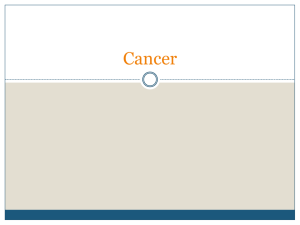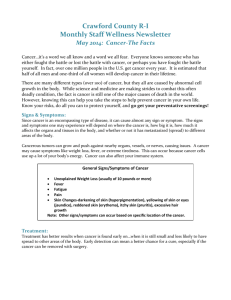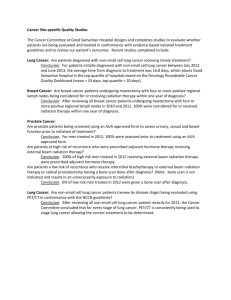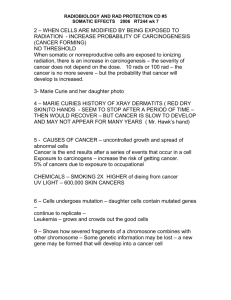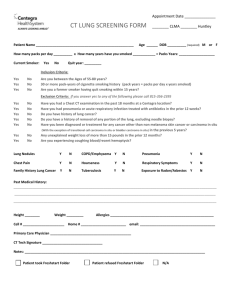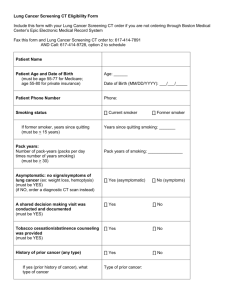Cancer PP
advertisement
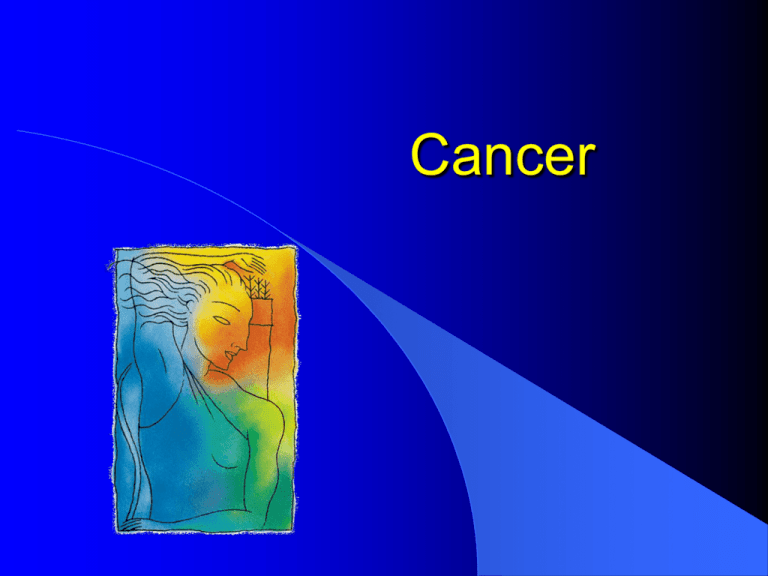
Cancer What is Cancer? • An uncontrolled growth and spread of abnormal cells. • A tumor is a mass of cells that grows more rapidly than surrounding tissue. • Malignant – very dangerous and harmful • Benign – Harmless, non-cancerous • Metastasis – the process where cancer spreads from one area of the body to a different area of the body. What Causes Cancer? • • • • • • • • Smoking Obesity A few viruses Chemicals Radiation Hormones Immune conditions Inherited genetic mutations Cellular Change & Mutation Theories • One theory is that cancer results from an error that happens during cell reproduction. • Another theory is that cancer is caused by some external agent that enters a normal cell and initiates changes. • Carcinogens include radiation, chemicals, hormonal drugs, toxins, smoking. • A third theory includes the research that certain viruses are believed to cause tumors in animals. Lifestyle Cancer Risks • Smoking can cause cancer of the lung, pancreas, bladder and kidney, larynx, mouth, pharynx, esophagus, stomach, liver, and cervix. • Cancer is more common in people who are overweight and lead a sedentary lifestyle • Including postmenopausal breast cancer, endometrium, gallbladder, kidney, cervix, ovaries, colon, and prostate. Biological Cancer Risks • Cancers of the breast, stomach, colon, prostate, uterus, ovaries, and lungs appear to run in families • Hodgkin’s disease and certain leukemia’s also run in families • Gender also affects certain cancers • Breast cancer usually occurs in females Environmental Cancer Risks • Asbestos, Nickel, chromate, benzene, arsenic, vinyl chloride, radioactive substances, radon exposures, coal tars, herbicides, and pesticides have been shown to be carcinogens for humans. Viral Cancer Risks • Cervical cancer has been linked to the human papilloma virus, the virus that causes genital warts. • The Epstein-Barr virus, which is associated with mononucleosis, may contribute to cancer. • The herpes-related viruses may be involved in the development of some forms of leukemia, Hodgkin’s disease, cervical cancer and Burkitt’s lymphoma. Types of Cancers • Carcinoma • Most common sites for cancer • Found in tissues that cover the body surfaces and linings in most body cavities. Form solid tumors. • Examples include: breast, lung, intestinal, skin, and mouth. Types of Cancers (Cont.) • Sarcoma • These cancers are less common, but are usually more dangerous. They also form solid tumors. • They occur in the middle layers of tissues • Examples include: bone, muscles, and connective tissues. Types of Cancers (Cont.) • Lymphoma • Develops in the lymphatic system (the infection fighting regions of the body) and forms solid tumors. • An example includes Hodgkin’s disease Types of Cancers (Cont.) • Leukemia • Cancer of the bloodforming parts of the body. • Usually the bone marrow and spleen that form non-solid tumors. • Characterized by an abnormal increase in the number of white blood cells. Lung Cancer • Symptoms include a persistent cough, blood-streaked sputum (mucus that is coughed up from the lower airways), chest pain, and recurrent attacks of pneumonia or bronchitis. • Treatment includes surgery, radiation and chemotherapy. • Risks include tobacco use, exposure to tobacco smoke, arsenic, asbestos or radiation. This normal gross appearance of a lung, in cross section, is shown here for comparison (Some Pictures) LUNG CANCER AND EMPHYSEMA Small cell anaplastic (oat cell) carcinoma of the lung appears here in a smoker. Smokers who stop will diminish their risk for lung cancer, even after just a couple of years. WHO WANTS THIS LUNG??? SQUAMOUS CELL CARCINOMA A large squamous cell carcinoma of the lung in a smoker is shown here. The incidence of both squamous cell carcinomas and small cell anaplastic carcinomas of lung is far greater in smokers than non-smokers. EMPHYSEMA Emphysema, of the centrilobular type, with numerous enlarged air spaces as a result of the loss of lung tissue from smoking is demonstrated here grossly. fds Breast Cancer • The earliest signs are observable on mammograms, usually before lumps can be felt. Self exams should begin by 20 with regular mammograms at the onset of sexual activity or age 30. • Once it has grown to where it can be felt, symptoms include lump, thickening, swelling, dimpling, skin irritation, distortion, retraction of the nipple, nipple discharge, pain or tenderness. • Treatments range from lumpectomy to radical mastectomy and various combinations of radiation or chemotherapy. • Risk factors include family history, long menstrual history, obesity after menopause, oral contraceptives, never having children. Breast Self Exam Testicular Cancer • Males between the ages of 17 and 34 with undescended testicles are at the greatest risk. • Symptoms include a painless enlargement of the testis or thickening in the testicular tissue. Testicular Self Exam Prostate Cancer • A PSA blood test and rectal examination can be used to screen males without symptoms. PSA blood test should begin at age 40. • Most signs of cancer mimic the signs of an infection or enlarged prostate. • Symptoms include weak or interrupted urine flow, difficulty starting or stopping urine, the need to urinate frequently, pain in lower back, pelvis, or upper thighs, blood in urine. • Risk factors increase with age, being African-American increases risk and family history. Colon and Rectum Cancers • Symptoms include bleeding from the rectum, blood in the stool and changes in bowel habits. • Colonoscopy or barium enemas are recommended tests for at-risk populations and people over 50. • Treatments include surgery, radiation and possible chemotherapy. • Risk factors include people who are over 40, obese, have a family history of these cancers and or polyps, inflammatory bowel problems, diets high in fats or low in fiber, smoking, high alcohol consumption, and inactivity. Colon and Rectum Cancers COLON POLYPS AND CANCER (Some Pictures) Tubular adenomas, larger than 2 cm, carry a much greater risk for development of a carcinoma, having collected mutations. The colonoscopy appearance of rectal polyps, in this photo, proved to be tubular adenomas. This colonoscopy view of small polyps proved to be a tubular adenoma. This polyp has a hemorrhagic surface (which is why they may first be detected with stool blood screening) and a long narrow stalk. The size of this polyp--above 2 cm--makes the possibility of malignancy more likely, but this polyp proved to be benign. Here are multiple polyps of the colon. A small portion of terminal ileum appears at the right. Here is another example of numerous small polyps covering the colonic mucosa. In this particular case, there were osteomas of the skull, a periampullary adeno-carcinoma, and epidermal inclusion cysts. Thus, this is a case of Gardner's syndrome. As with familial adenomatous polyposis, the inheritance pattern is autosomal dominant. These are colonoscopy views of a smaller rectal adeno-carcinoma with an ulcerated surface. SKIN CANCER Skin cancer is the fastest growing type of cancer in the US. Over 2 million people will be diagnosed with skin cancer this year. (National Cancer Inst.) Many studies show a correlation between exposure to UV radiation and skin cancer rates. MOST COMMON TYPES Basal Cell Carcinoma Cells of the stratum basale start to divide uncontrollably. Most common and least dangerous form of skin cancer. Slow growing, and is usually detected before it spreads. Squamous Cell Carcinoma Cells of the stratum spinosum start to divide uncontrollably. Often appears on the scalp, ears, lips or hands. Fast growing, but prognosis is good if caught early and removed. Squamous Cell Carcinoma WARNING: THE FOLLOWING IMAGE MAY BE DISTURBING!!! Malignant Melanoma Cancer of melanocytes (melanin producing cells) 5% of skin cancer, but is increasing rapidly and is the most deadly form. Develops in pigmented regions of the skin. Early detection is critical! Skin Cancer • Melanomas of the skin are most common on the face, ears, neck, arms, hands and legs. • They usually appear as warty bumps, colored spots or scaly patches with asymmetry, and border irregularity and variations in color. • Risks include radiation from the sun and tanning lamps. Avoid sun or use a strong sun block. SPF = sun protection factor. Higher number provides more protection. • Surgery is used with possible radiation or chemotherapy. Sun safety care The following are things we can all do to avoid sun damage. Just listen to Sid the safety Seagull and abide by these simple rules…. • • • • • Slip on a shirt Slop on some sunscreen/sunblock (SPF 15+) Slap on a hat Seek shade (between the hours of 10am & 4pm) Slide on some sunglasses (UVA/UVB protection approved) Ovarian Cancer • Most common symptoms include enlargement of the abdomen in women over 40, gas, stomachaches that cannot be explained. • Risk factors include exposure to estrogen and family history. Uterine Cancer • Early warning signs include bleeding outside of normal menstrual periods or after menopause or unusual vaginal discharge. • Risk factors include early age of first intercourse, multiple sex partners, cigarette smoking, certain STD’s, a family history, a history of infertility, failure to ovulate, obesity, and estrogen therapy. Leukemia • Cancer of the blood-forming tissues that leads to millions of immature white blood cells. • These abnormal cells crowd out normal blood cells. • Symptoms include fatigue, paleness, weight loss, easy bruising, repeated infections, nosebleeds and other hemorrhaging. EARLY WARNING SIGNS OF CANCER If you have any of these early warning signs, contact your physician. Early detection is essential for improved survival for patients with cancer. Although these signs may seem vague, they may indicate that cancer is present. C A U T I O N !!! C – Change in bowel habits may be a sign of colorectal cancer. Constipation or diarrhea accompanied by abdominal pain may indicate there is a tumor blocking your colon. A MAJOR symptom of cancer is discharge of blood in stool. A – A sore that does not heal. Smokers and people who use chewing tobacco may develop oral leukoplakia. Oral leukoplakia are rough white patches which form in the mouth. These may develop into cancer. U – Unusual bleeding or discharge from the rectum, bladder or vagina may indicate signs of cancer. EARLY WARNING SIGNS OF CANCER (Cont.) T – Thickening or lump in breast or elsewhere. Breast cancer may also include retraction of the nipple, nipple discharge, pain or tenderness in that area. I – Indigestion or difficulty in swallowing. Can be a sign of esophegeal or stomach cancer. O- Obvious change in a mole or wart. This can be a sign of melanoma , or skin cancer. N – Nagging cough or hoarseness. This may be an early sign of lung cancer, which is the number one killer in men and women who have cancer. Top 10 Ways To Prevent Cancer 1. Avoid smoking, whether it be actual smoking or second hand smoke. 2. Practice sun safety and recognize when skin changes occur. 3. Eat your fruits and veggies. 4. Watch the meats you eat, especially smoked or cured foods. 5. Limit your alcohol intake. “CANCER CURES SMOKING” Top 10 Ways To Prevent Cancer (Cont.) 6. Exercise for cancer prevention 7. Know your personal and family history of cancer. 8. Know your personal and family history of cancer. 9. Know your personal and family history of cancer. 10. Be sure to keep up on screening tests like the Pap, mammograms, and DREs. Detecting Cancer • Magnetic Resonance Imaging (MRI) • A device that uses magnetic fields, radio waves and computers to generate an image of internal tissue of the body without the use of radiation. • Computerized Axial Tomography (CAT scan) • A machine that uses radiation to view internal organs not normally visible on x-rays. Cancer Treatments • Surgery • The tumor and surrounding tissue is removed. • Radiotherapy • The use of radiation to kill cancerous cells • Used to treat localized cancer cells, but also destroys some healthy cells. • Chemotherapy • The use of drugs to kill cancerous cells • Used to treat cancers that have spread throughout the body.
